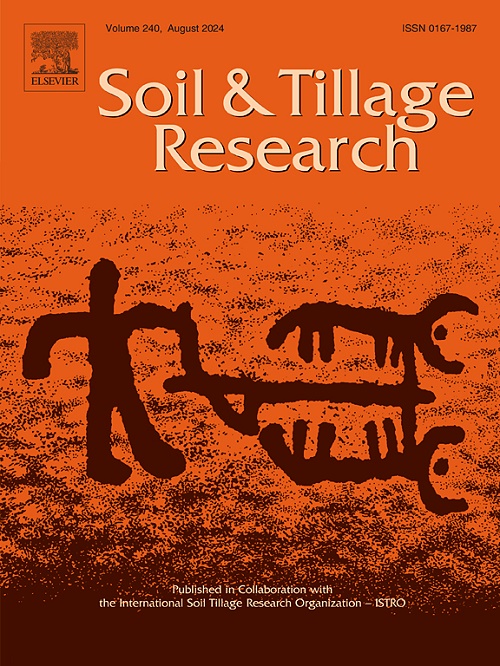在土壤中施用人造沸石能迅速提高土壤pH值,增强无机碳固存
IF 6.1
1区 农林科学
Q1 SOIL SCIENCE
引用次数: 0
摘要
土壤拥有巨大的碳储量。虽然对土壤有机碳(C)动态进行了大量的研究,但对土壤无机碳(SIC)的关注较少。在这里,我们研究了沸石改性剂对SIC的隔离潜力。支持这项研究的基本原理是沸石——即高ph值、富含碱性的铝硅酸盐矿物——可以促进土壤碳酸盐化合物的稳定。通过80个容器的析因实验室孵育实验进行了为期4个月的研究,实验包括两种土壤类型(壤土Planosol和粘土Vertisol)、4种人造沸石和对照(仅限土壤),每种处理4个重复。另外一系列容器,将粉碎的镁基(高镁)岩石与上述处理相结合,作为无机碳封存方法的基准。在试验结束时,沸石使土壤pH值平均增加了1.5个单位(p <; 0.05),而粉碎的基质对土壤pH值的影响要小得多。当所有处理的平均值时,沸石的添加导致SIC浓度比对照增加了70 % (p <; 0.05)。它们在Planosol中特别有效,每个沸石产量显著(p <; 0.05),相对于对照组,SIC浓度显著提高(高达230 %)。质量平衡计算证实,这些增加不可能是由沸石中相对较少的IC含量引起的。x射线衍射分析证实在某些沸石土壤处理中存在少溶性碳酸盐物质。单独的基性岩石没有引起明显高于对照的碳化硅浓度。此外,沸石与基质的结合没有发现增效作用。数学很可能需要更长的时间才能发挥作用。总的来说,我们的研究表明,沸石可以潜在地增加SIC储量并缓冲土壤酸化,尽管需要在野外规模上对该方法进行验证。鉴于先前的研究报告指出,沸石可以实现其他益处,包括增强土壤有机碳固存和改善土壤水分和养分保留,这些矿物质可以开发成高价值和多效益的修正物,以支持农业、景观恢复和减缓气候变化。本文章由计算机程序翻译,如有差异,请以英文原文为准。
Manufactured zeolite application to soil can rapidly increase pH and enhance inorganic carbon sequestration
Soils host enormous carbon stocks. Whilst considerable research has been dedicated towards soil organic carbon (C) dynamics, less attention has been paid to soil inorganic carbon (SIC). Here we investigated zeolite amendments for their potential to sequester SIC. The rationale underpinning the investigation is that zeolites – i.e., high-pH, alkaline-rich aluminosilicate minerals – could promote stabilisation of soil carbonate compounds. A four-month study was undertaken via an 80-container factorial laboratory incubation experiment comprising two soil types (a loamy Planosol and a clayey Vertisol), four manufactured zeolites, and a control (soil only), with four replicates for each treatment. An additional series of containers, containing crushed mafic (high magnesium) rock combined with the above treatments, was included as a benchmark inorganic carbon sequestration method. The zeolites increased soil pH by an average of 1.5 units (p < 0.05) at the trial’s conclusion, whereas the crushed mafics had much less impact on soil pH. Zeolite addition resulted in a 70 % increase (p < 0.05) in SIC concentrations compared with controls when averaged across all treatments. They were particularly effective in the Planosol, with each zeolite yielding significantly (p < 0.05) and substantially higher (up to 230 %) SIC concentrations relative to the controls. Mass balance calculations confirmed these increases cannot have been caused by the relatively minor IC contents of the zeolites. X-ray diffraction analysis confirmed the presence of sparingly-soluble carbonate species in some of the zeolite soil treatments. Mafic rock alone did not cause appreciably higher SIC concentrations than the controls. Moreover, no synergistic effects were observed when combining zeolites with mafics. It is likely that mafics require a longer timeframe to be effective. Overall, our study revealed that zeolites can potentially increase SIC stocks and buffer against soil acidification, although confirmation of the method at field scale is needed. Given previous research has reported that zeolites can achieve other benefits, including enhanced soil organic C sequestration and improved soil water and nutrient retention, these minerals could be developed into high-value and multi-benefit amendments to support agriculture, landscape restoration and climate change mitigation.
求助全文
通过发布文献求助,成功后即可免费获取论文全文。
去求助
来源期刊

Soil & Tillage Research
农林科学-土壤科学
CiteScore
13.00
自引率
6.20%
发文量
266
审稿时长
5 months
期刊介绍:
Soil & Tillage Research examines the physical, chemical and biological changes in the soil caused by tillage and field traffic. Manuscripts will be considered on aspects of soil science, physics, technology, mechanization and applied engineering for a sustainable balance among productivity, environmental quality and profitability. The following are examples of suitable topics within the scope of the journal of Soil and Tillage Research:
The agricultural and biosystems engineering associated with tillage (including no-tillage, reduced-tillage and direct drilling), irrigation and drainage, crops and crop rotations, fertilization, rehabilitation of mine spoils and processes used to modify soils. Soil change effects on establishment and yield of crops, growth of plants and roots, structure and erosion of soil, cycling of carbon and nutrients, greenhouse gas emissions, leaching, runoff and other processes that affect environmental quality. Characterization or modeling of tillage and field traffic responses, soil, climate, or topographic effects, soil deformation processes, tillage tools, traction devices, energy requirements, economics, surface and subsurface water quality effects, tillage effects on weed, pest and disease control, and their interactions.
 求助内容:
求助内容: 应助结果提醒方式:
应助结果提醒方式:


